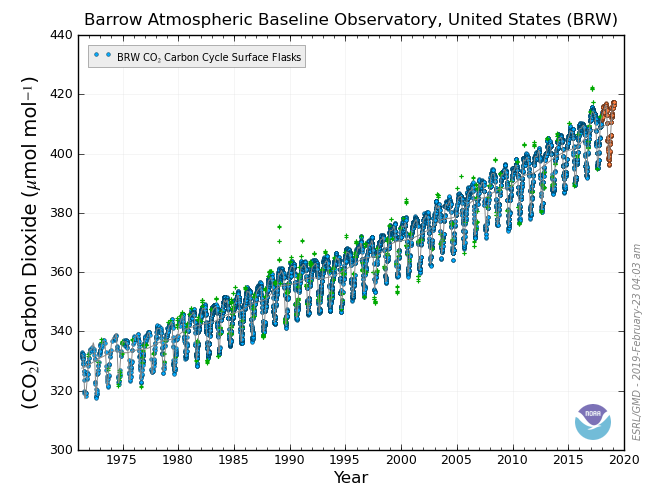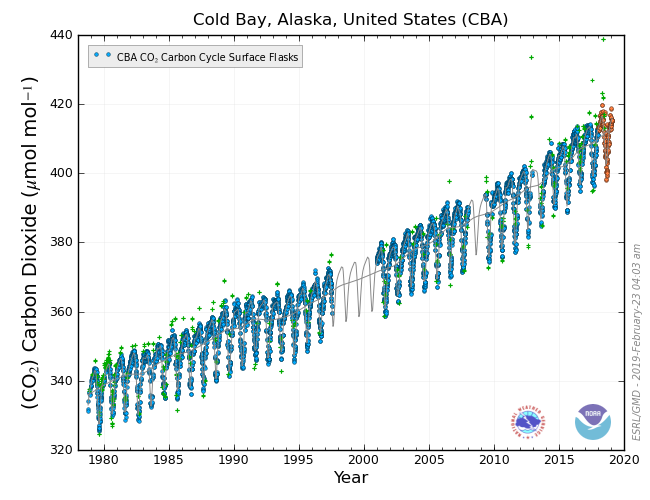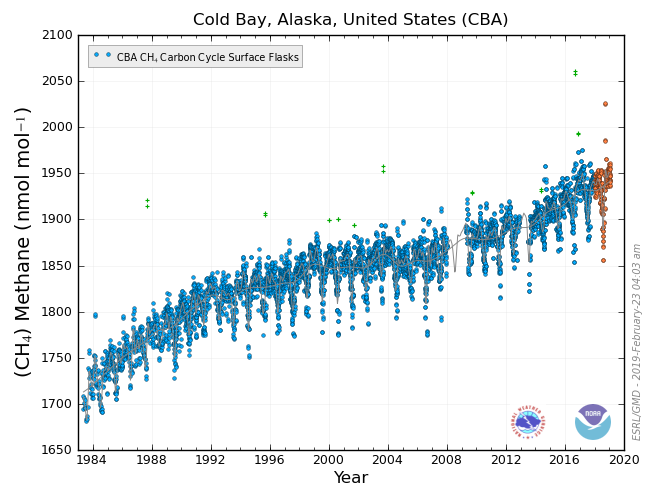Let's hope the data at the far right (which is preliminary and unconfirmed) represents a measurement artifact and not the postscript to Ed Dlugokencky recent reassurances:
Which could indicate the sensors are off. On the other hand, we would expect a significant fraction of any undersea methane release to be oxidized to CO2, and melting permafrost also releases both gases . . . so I don't know that the presence of a similar anomalous spike in the CO2 measurements really helps us decide if the methane spike is real. Only time will tell, I suppose . . . updates as I find them.
UPDATE:
Cold Bay shows a spike for CO2:
But nothing out of the ordinary for methane:
While NOAA's interactive map is incredibly helpful, what one would not give for a few Siberian sites.
[B]ased on what we see in the atmosphere, there is no evidence of substantial increases in methane emissions from the Arctic in the past 20 years.This came up at Neven's, whereupon it was pointed out that CO2 is spiking too:
Which could indicate the sensors are off. On the other hand, we would expect a significant fraction of any undersea methane release to be oxidized to CO2, and melting permafrost also releases both gases . . . so I don't know that the presence of a similar anomalous spike in the CO2 measurements really helps us decide if the methane spike is real. Only time will tell, I suppose . . . updates as I find them.
UPDATE:
Cold Bay shows a spike for CO2:
But nothing out of the ordinary for methane:
While NOAA's interactive map is incredibly helpful, what one would not give for a few Siberian sites.




I think PB may really be the best spot for monitoring ESAS emissions since it's downwind. Local monitoring might not be better.
ReplyDeleteNote that Cold Bay is way south in the Aleutian region, and perhaps methane and CO2 mix differently short-term.
But it seems like one wouldn't expect an associated CO2 spike from oxidation over such a short time. The process is fast, but not that fast, plus I suspect the relative quantities wouldn't match too well, methane being measured in ppb and CO2 in ppm, i.e. a serious-looking methane spike wouldn't turn into enough CO2 to sneeze at.
Could Cold Bay be subject to CO2 spikes from local vulcanism, or even from Siberia?
"I think PB may really be the best spot for monitoring ESAS emissions since it's downwind. Local monitoring might not be better."
ReplyDeleteHelp a newbie out -- "PB"?
"But it seems like one wouldn't expect an associated CO2 spike from oxidation over such a short time."
Absolutely, but, a couple things:
* Atmospheric oxidization would be way too slow, but what about oxidation in the ocean?
* Wouldn't straight permafrost melting create a lot of CO2 and a little methane, like we see here?
Of course if we're playing odds, it's probably a error somewhere.
Seems like the wrong time of year for a spike from either of those, and re the former the quantities still seem mismatched.
ReplyDeleteBut is there a possibility of direct CO2 emissions from the undersea permafrost (maybe that's what you meant,rather than land) earlier in the year, finally reaching saturation and being emitted now?
Well, I have no idea, not being qualified to even play an expert on TV. :)
Instrument issues do seem the most likely explanation still, but how common are errors that affect both at once?
Anyway, you know what they say, a watched ocean never boils, except on galactic time scales. :)
PB => Point Barrow
Thanks, good info!
ReplyDeleteYour blog looks really great Thanks a lot for your valuable article.
ReplyDeleteac duct cleaning Bay Harbor Islands fl
look at Ant Artic ice volume INCREASING
ReplyDeleteتاتش
ReplyDeleteتكسير سيراميك في عجمان
مقاول تشطيبات في عجمان
شركات صبغ فى عجمان